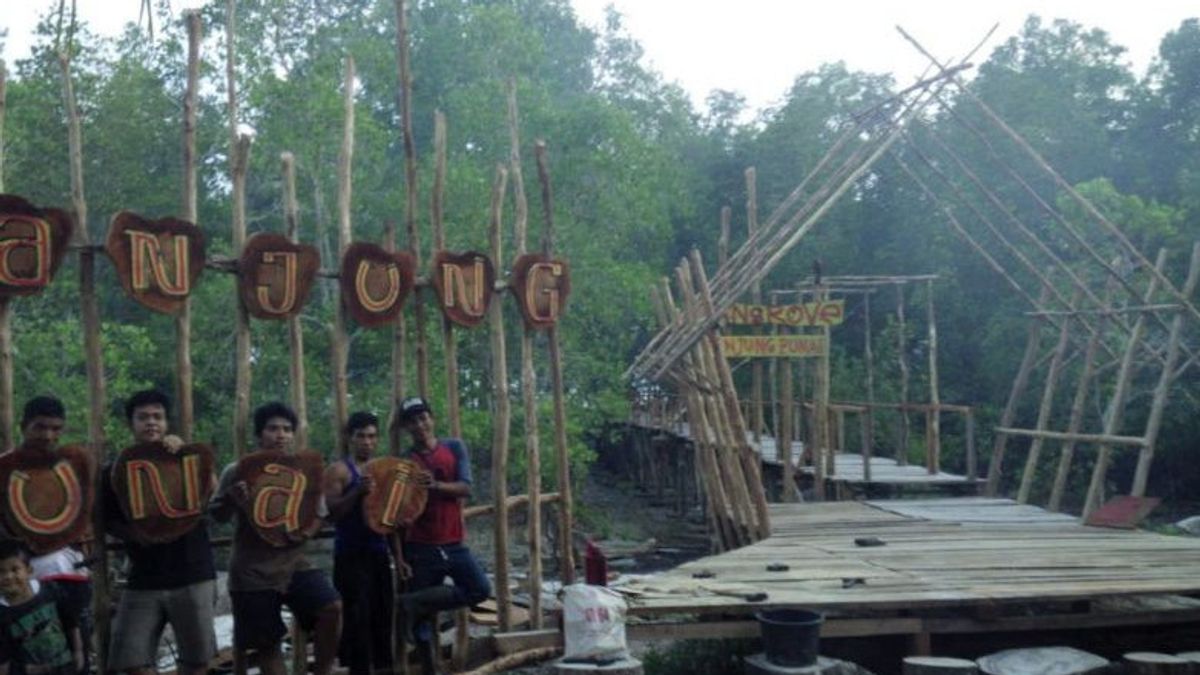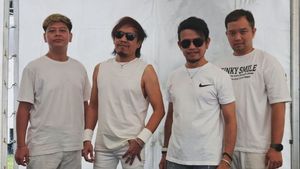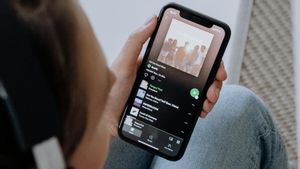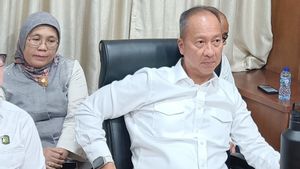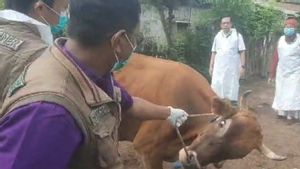JAKARTA - For some people, blue carbon or blue carbon may still sound foreign. Likewise for residents of the coast of Tanjungpunai, West Bangka Regency, Bangka Belitung Islands Province, who live a daily life in the midst of a heavy mangrove.
They are too busy scavenging mud to look for various marine animals, such as shells, berengs, shrimp, crabs, crabs,apors, and various other edible animals, or if they get more results, they can be sold to meet their daily needs.
Their busyness with the nature around them further distances from various issues that develop outside, for example, discussing the issue of climate change, greenhouse effects, and various other environmental issues that are becoming a hot topic for high-ranking officials around the world.
For them, preserving mangrove forests and using them wisely is a must because they are very aware that from the forests on the coast the life of all family members and descendants of the next generation is hanging.
Launching Antara, coastal residents naturally make mangroves a identity that must stay alive, grow, and sustainably because they believe that through mangrove sustainability they will provide life from generation to generation.
Along with the important role of mangroves as a support for life and livelihoods for coastal residents, it turns out that the existence of these plants plays an important role for the life of all beings on Earth.
Mangroves are not just places to find food for coastal residents, breeding grounds for various marine animals, and other animals in the forest, but have an important role in capturing and storing blue carbon.
Blue carbon is a term used for carbon emissions reserves that are absorbed, stored, and released by coastal and marine ecosystems to reduce the emission that causes climate change by utilizing coastal areas, mangroves, wetlands and seagrass fields (seagrass).
Other benefits from blue carbon, among others, as an effective carbon absorber, a natural solution to climate change triggered by greenhouse effects or an increase in the amount of CO2, preserving coastal ecosystems, and of course as a source of the economy of coastal communities by providing ecological protection.
Blue carbon is captured and stored by organisms in coastal areas, oceans through photosynthesis processes and accumulated in biomass of mangrove plants, seagrass, phytoplankton, and seaweed.
Blue carbon is different from green carbon or terrestrial carbon stored in biomass and soil in plants, forests, plantations, agricultural land, and peatlands.
In Indonesia, blue carbon is scattered in coastal ecosystems such as mangrove forests, mangrove forests, seagrass fields, and peatlands in coastal areas.
The potential for blue carbon in Indonesia is very large, reaching 3.4 giga tons (GT) or about 17 percent of the world's blue carbon.
Based on the national mangrove map released by the Ministry of Environment and Forestry in 2021, Indonesia's total mangrove area is 3,364,076 hectares, with details of the heavy mangrove conditions covering an area of 3,121,239 hectares (93 percent), moderate mangroves covering an area of 188,363 hectares (five percent), and rare mangroves covering an area of 54,474 hectares (two percent).
Blue carbon has been a very serious discussion at the international level, even European Union and North American countries, including being very ambitious by applying high carbon prices.
In Indonesia, this issue has also become the government's concern, as evidenced by the plan to implement a carbon tax regulated in Law Number 7 of 2021 concerning Harmonization of Tax Regulations (HPP). Imposition of a carbon tax is needed to reduce emissions and prevent extreme climate change. The regulation states that the price of carbon is around Rp. 30,000/ton.
Blue carbon guard
Without realizing it, it turned out that the activities of the Tanjungpunai coastal residents who took care of nature and used them wisely there made them one of the guardians of the blue carbon contained in the mangrove forest in the area.
Based on data from Bakosurtanal in 2009, the mangroves on Bangka Island covering an area of 47,621 hectares, while the mangrove area in Tanjungpunai is 1,988.7 hectares or about 4.18 percent.
The dominant types of mangrove plants in Tanjungpunai are Sonneratia alba, but there are also other types in the form of Rhinopora apiculata, with a density rate of 7.5 percent very rarely, 7.0 percent rare, and 85.5 percent heavy.
Tanjungpunai is not only rich in blue carbon, but also has extraordinary natural potential, in addition to having geological diversity (geo-diversity), flora and fauna (bio-diversity) and local customs (cultural-diversity).
Since early 2019, women activists living in Tanjungpunai Mentok, Ardianeka, have been very aware of the importance of maintaining blue carbon around their homes, this awareness is the driving spirit to form environmentally aware groups of society.
With a tireless struggle, Ardianeka finally managed to initiate the formation of three community groups on the coast, namely the Tanjungpunai Tourism Awareness Group (Pokdarwis), the Tanjungpunai Forest Farmers Group, and the Belangkas MSME Group.
They collaborated on the management of coastal areas including mangrove forests located around the Tanjungpunai protected forest and forest by implementing the geopark concept by presenting Mangrove Tanjungpunai as the Green Blue Integrated Zone (GBI Zone).
Geopark is one of the concepts of environmental protection and management that combines geo-diversity, bio-diversity and cultural-diversity elements, which exist in an area in order to protect and improve the function of natural heritage.
An area can be proposed as a geopark area starting with a downward and upward process involving all communities and stakeholders by aligning the three types of diversity.
This concept is carried out in order to support sustainable development by emphasizing conservation, education, and local economic growth activities.
The GBI Zone is a concept of protection, management and utilization of natural resources in an area in order to protect the surrounding environment to improve the economy of the community around the area consisting of coastal areas, mangroves and forest areas.
Management and development of coastal areas and Tanjungpunai mangroves are the focus of activities to be used as integrated zones, this activity is a joint commitment to improve the economy of the surrounding community with their natural potential.
There are also many types of fish in mangroves, such as nines, bereaks, jumpouls, anchovies, tambans, kepetek, pari, hoses as well as shrimp, and mangrove crabs.
"In addition to utilizing the existing natural wealth, currently in the sea area there is also a shrimp pond of around 150 hectares. Meanwhile, in the land area, some of it is used for planting jambu metes in collaboration with BPDAS Bangka Belitung covering an area of 10 hectares," said Ardianeka.
Through the three community groups that have been formed, the existence of mangrove forests is increasingly preserved and the ingredients in them can be utilized properly and wisely to improve the welfare of group members and local residents.
Cultural approach
For residents who are on the east tip of Mentok District, local cultural customs are still preserved because they have local wisdom values that deserve to be passed down to the next generation.
One tradition passed down from generation to generation is the Ruah Traditional Party which is held every year welcoming the Holy Month of Ramadan, this tradition is part of the life of the Tanjungpunai people.
"This traditional activity is our starting door in introducing potential in the village, one of which is that we include the introduction of the concept of local geoparks," said Ardianeka.
With such an approach pattern, it is hoped that it will become new knowledge and increase insight for local residents, especially the younger generation so that they can work together to develop the potential that exists in Tanjungpunai.
After the formation of three community groups in Tanjungpunai Hamlet, in the future it is planned that a conservation agency can be built to preserve the environment, breeding and saving plants and animals while maintaining the purity of their species.
In addition, the existence of these institutions can also function as places of education, demonstrations and research as well as the development of science.
"We dream that we can have conservation institutions, for example, in the form of zoologies, special animal parks, special animal training centers, botanical gardens, functories, and special plant parks, or in other forms of institutions," he said.
With existing institutions, it is believed that the community will be increasingly motivated in environmental conservation because it will increase the welfare of life. In this preservation, the community can take full advantage of the existence of mangrove areas and be responsible.
For pokdarwis, the Tanjungpunai Mangrove area can be used as an encouraging tourist destination and produce not only for pokdarwis members, but also for local residents.
The Tanjungpunai Coast can also be used for blood-shell cultivation activities with a total area of land that can be utilized reaching 205 hectares.
Housewives who are members of the Belangkas MSMEs have also been gradually given skills by processing marine products in the form of anchovy, shells, dives and others into processed foods and frozen foods.
Meanwhile, KTH Tanjungpunai is currently processing guava to be used as processed food and sold in the form of packages processed using modern tools.
Various skills with a touch of modern equipment that has been carried out so far are expected in the future the welfare of residents on the coast of Tanjungpunai to be more advanced, prosperous and dignified.
The English, Chinese, Japanese, Arabic, and French versions are automatically generated by the AI. So there may still be inaccuracies in translating, please always see Indonesian as our main language. (system supported by DigitalSiber.id)
